With hands shielding the sun from our eyes, we scan the brown, barren emptiness of Hakatere Conservation Park. Several mountain ranges encircle us like we’re in the centre of a gigantic crater. A light breeze carries the sound of barking, but the undulating landscape hides the culprit from view.
“Does he usually come back?” Adam asks, between sips from his water bottle.
“Usually,” I sigh. We’ve not even left the car yet, and I’ve already managed to lose him. I clamber onto the roof and shout his name. In the distance, I can see a black blur chase several birds that soar high above. “Don’t worry, I can see him.”
Adam squints as if he’s on safari trying to spot a wild animal across the savanna-like wilderness. “Is he coming back?”
My arms fall to my side. “…doesn’t look like it.”
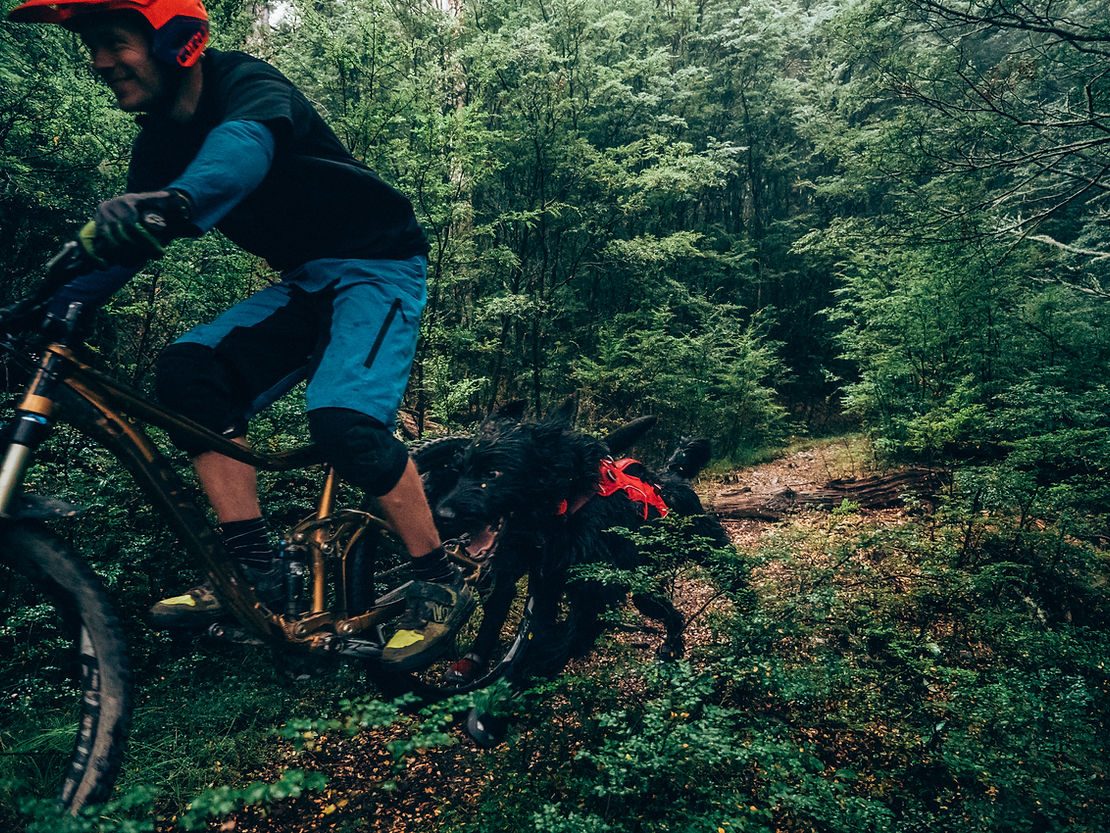
Up until three years ago, I’d never owned or spent much time around dogs. I didn’t grow up with one in the family and was generally indifferent to the four-legged, tail wagging species. So when my partner suggested we get a puppy, I was finally swayed by the possibility of having a trail dog. I’d seen plenty of riders out on the tracks with well-mannered, obedient canines at their side, and it seemed an ideal way to combine the chore of dog walking with the joy of mountain biking. Training can’t be that difficult? Sit, stay, sick balls – easy. As I watched my not-so-faithful companion disappear over the Hakatere horizon, it appeared there was still a bit of work to do.
A Bikers Best Friend?
On paper, a trail dog should be your favourite riding partner. They won’t cancel when it looks like rain; they’ll never struggle through a hangover during a weekend jaunt, and their infectious energy can power you up the worst of climbs. However, something I had failed to consider when observing other trail dogs out on the local tracks was that I was witnessing the finished product. It can take months – even years – of training to get a canine to a point where they are trustworthy and capable enough to be taken out for a few laps.
Before we’d even got our dog Oshy near a bike, we had noticed a few of his quirky traits. Some of which lent themselves to the possibility of trail dog material, others… not so much. His breed is a cross between Border Collie and Huntaway. Which I appreciate doesn’t mean a great deal to non-dog people. Put simply, both varieties are energetic and bred to herd livestock, with Collies being the brains, i.e. able to follow commands, and Huntaways being the muscle, i.e. barks a lot.
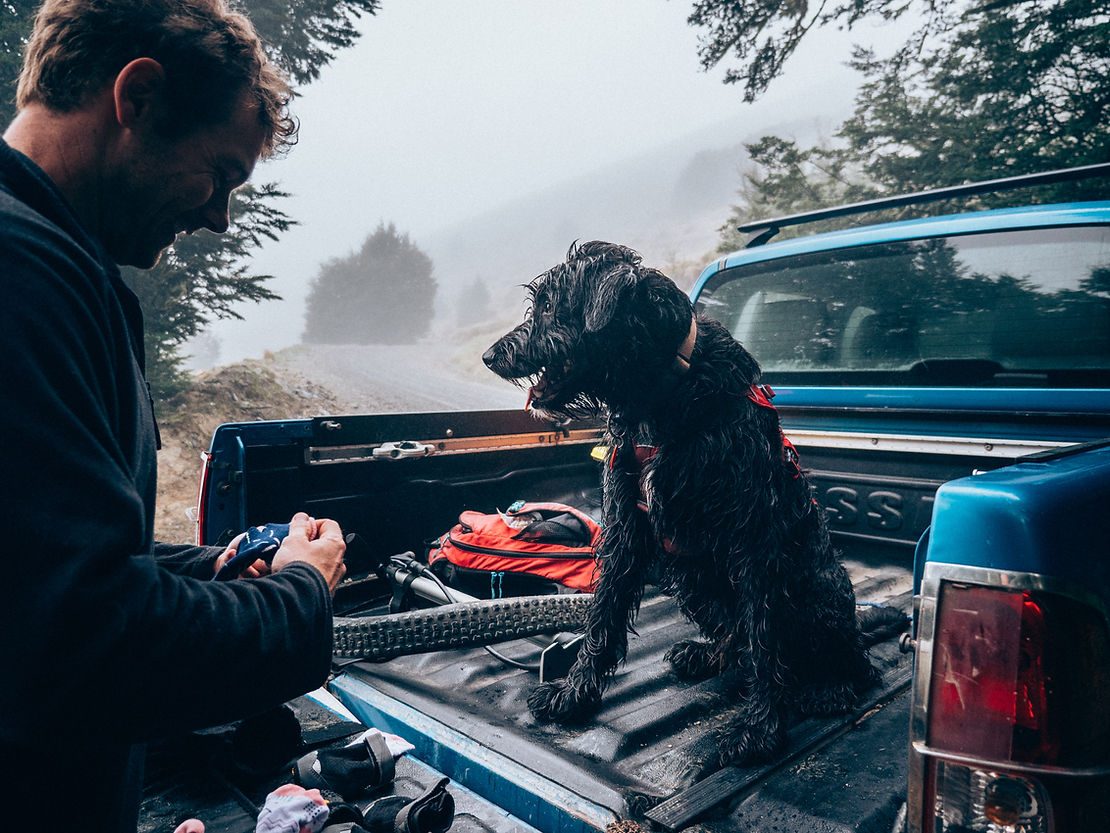
Understanding the breed and body type of your potential trail dog is important as it can dictate how they will cope when joining you for a ride.
“Generally speaking, larger dogs with long legs and long snouts are ideal,” explains Lisa Sturm, a trainer at Sit Happens, Dog Training Christchurch. “But that doesn’t include Greyhounds, as although they may appear light and quick on their paws, they have been bred for short, high-intensity exercise.”
Before we had consulted with Lisa, we’d helplessly watched Oshy chase seagulls for over an hour at the beach, so we knew his stamina was up to it. She recommended working on his control around chasing things first, before taking him out with the bike. Once that was sorted, Lisa suggested starting small and somewhere quiet for the inaugural ride, which is how we came to be in Hakatere Conservation Park.
Take One
Hakatere lies within the depths of Canterbury, and although not famous for mountain biking, it is remote. I’d plotted a course to the tantalisingly named Mystery Lake. The route followed an uneventful 4WD track in and returned via a surprisingly fun section of the famed Te Araroa walking trail.
Before we released the hound, we laid a short trail of dog biscuits for him to seek out and enjoy, helping to focus him before the ride. We made the mistake of leaving him to it while we sorted the bikes out, and once the biscuits were done, he unfortunately moved his attention back to the birds again.
Eventually we regrouped and set off, and it was only a matter of time before another mistake became evident. What I hadn’t fully taken into consideration was the distance. It was upwards of 30 kilometres, and we were out for far longer than planned. Before we’d even made it back to the car, Oshy was starting to stiffen up. He spent the following few days on his bed, staring at me with accusatory eyes.
Once the guilt had subsided, I began pouring over Topo-maps and DOC information, searching for suitable places for a second attempt. Then the obvious occurred to me – Craigieburn. Those that have ridden there will be familiar with the selection of soft, loamy trails and spectacular views it offers. With it being relatively quiet and full of shorter 10 km loops, it was an ideal location.
I was also keen to try some new commands we’d been working on, such as ‘Behind,’ ‘Wait,’ and ‘Let’s Go.’ I’d practised them while riding around the front garden, tossing out treats like confetti at a wedding when Oshy got it right.
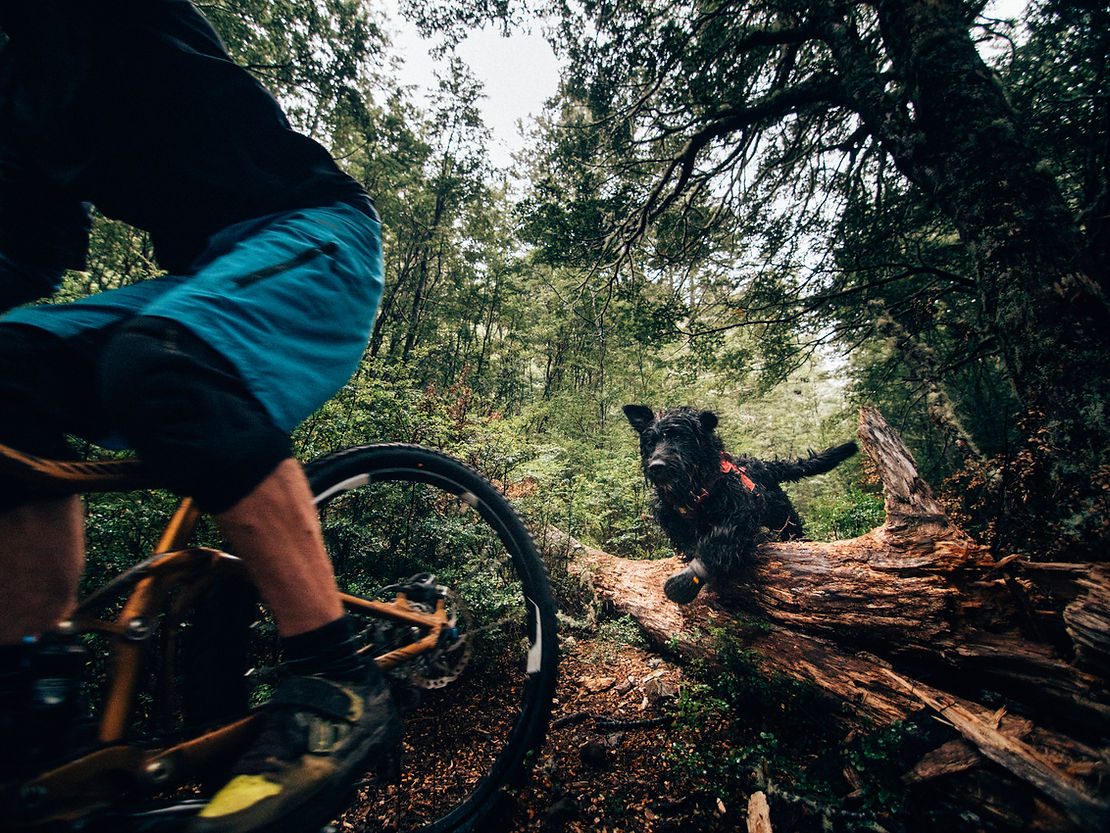
Take Two
On a crisp, bluebird day we slogged our way up the meandering Craigieburn access road to the base of the ski field. Sat at the start of a trail called The Edge, we both took a moment to enjoy the fresh alpine air and scenic views, before embarking – excuse the pun – on the track. This time the distance was right, and the commands worked suspiciously well, with Oshy waiting for the order to start, and staying behind the bike when instructed.
The Craigieburn trails are mostly through native forest, which provides welcoming shade, and we stopped at the many streams that trickle down the mountainsides so Oshy could keep hydrated. An important aspect to be aware of as you’re freewheeling down your favourite trail is that dogs can’t cruise, and can, therefore, be susceptible to over-heating.
Unfortunately, what I hadn’t taken into consideration was the trail surface. It’s called The Edge for a good reason – sections of it traverse over steep scree slopes. As well as being a bit sketchy in places, it didn’t do any favours for Oshy’s paws while he dashed over the jagged shingle. During the drive home I heard a constant licking noise, and on closer inspection, it appeared that he had torn his pad. Another wave of guilt washed over me. There was only one thing for it; it was time to go shopping.
Retail Therapy
“First and foremost, I’d recommended a set of booties,” Rocky suggested, holding up a pair of adorable dog shoes. Oshy and I were in FurtherFaster, an outdoor store in Christchurch, which has a whole section dedicated to arming your canine for adventure. There are collapsible water bowls, dog-specific first aid kits and all-weather dog coats.
As we measured up Oshy for some new boots, Rocky told me about Badger, their three-year-old Labradoodle. The large, shaggy dog bears an uncanny resemblance to Oshy, except instead of barking there is a continuous desire to chase toys.
“These days he’s more of a trail running dog,” Rocky says as we measure up Oshy’s paws, “due to the requirement for dogs to be on leashes when up on the Port Hills.”
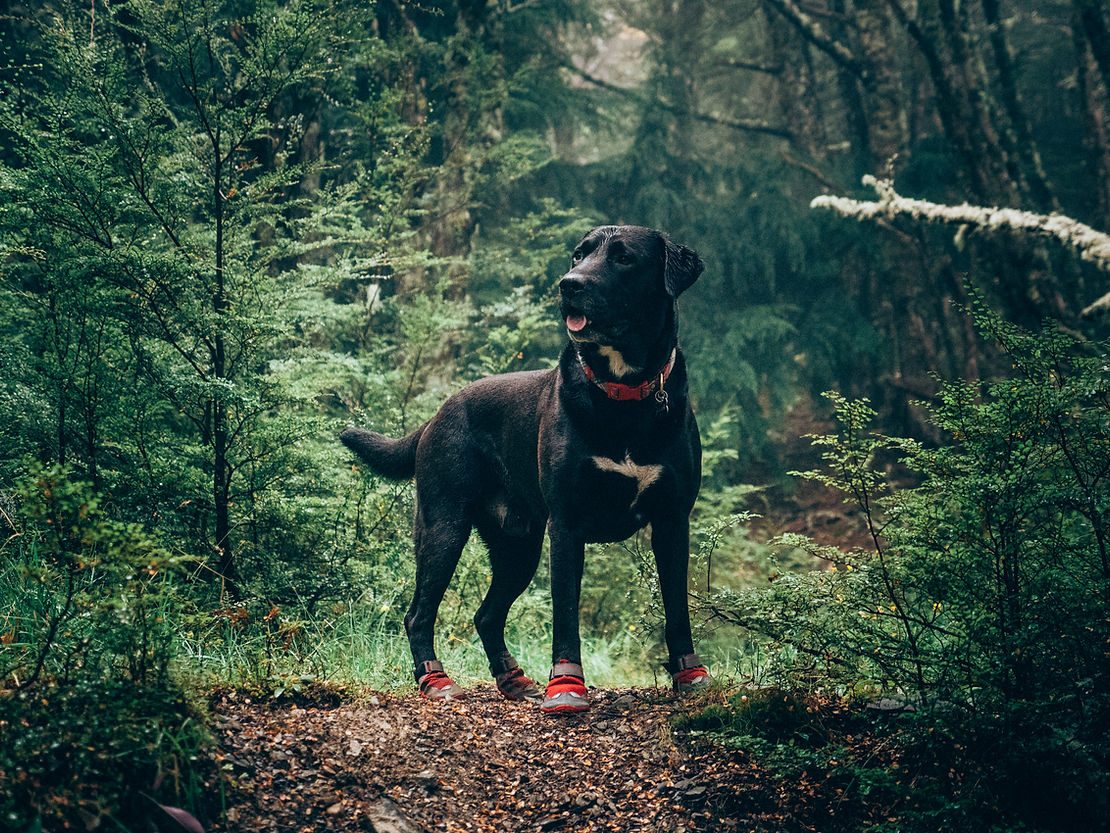
It’s a bad idea to have your dog tethered to your bike as it can lead to all kinds of accidents. If you’re worried about your dog running off, or want to train them to run next to the bike, there are devices available. An example is the ‘Walky Dog Plus’ which safely attaches the dog’s leash to the seat post, but bear in mind that it’s only suitable for wider trails.
With the boots fitted, my attention shifted to the selection of dog bags that can turn your pooch into something resembling a pack horse. The contents of my bike rucksack were evolving, and I was now hauling around biodegradable poo bags, a whistle, a leash and about a kilos worth of dog biscuits. Seeing as dogs can carry about 10% of their body weight, the thought of delegating some provisions to Oshy seemed an attractive one – especially as he never chips in for petrol.
At the counter, I asked if Rocky had any final advice. “Start small and somewhere quiet, and take plenty of water.” He then added with a grin, “and make sure you enjoy yourselves.”
Take Three
For the next attempt, I decided to bring some moral support. For anyone who has biked around Victoria Park in Christchurch, or been along to the dig days, they may be familiar with Frank (the Tank). A well-mannered, five-year-old Labrador-Border Collie cross. he can often be spotted taking sneaky hotlines and shortcuts as he races his trail buddies, Todd and Agata, through the steep and twisty downhill trails of the park.
I had hoped that the calm and collected presence of Frank, who has several years of trail running experience under his collar, would have rubbed off on Oshy, but alas. During a drizzly Saturday morning at Craigieburn, the sound of barking could be heard echoing through the mountains.
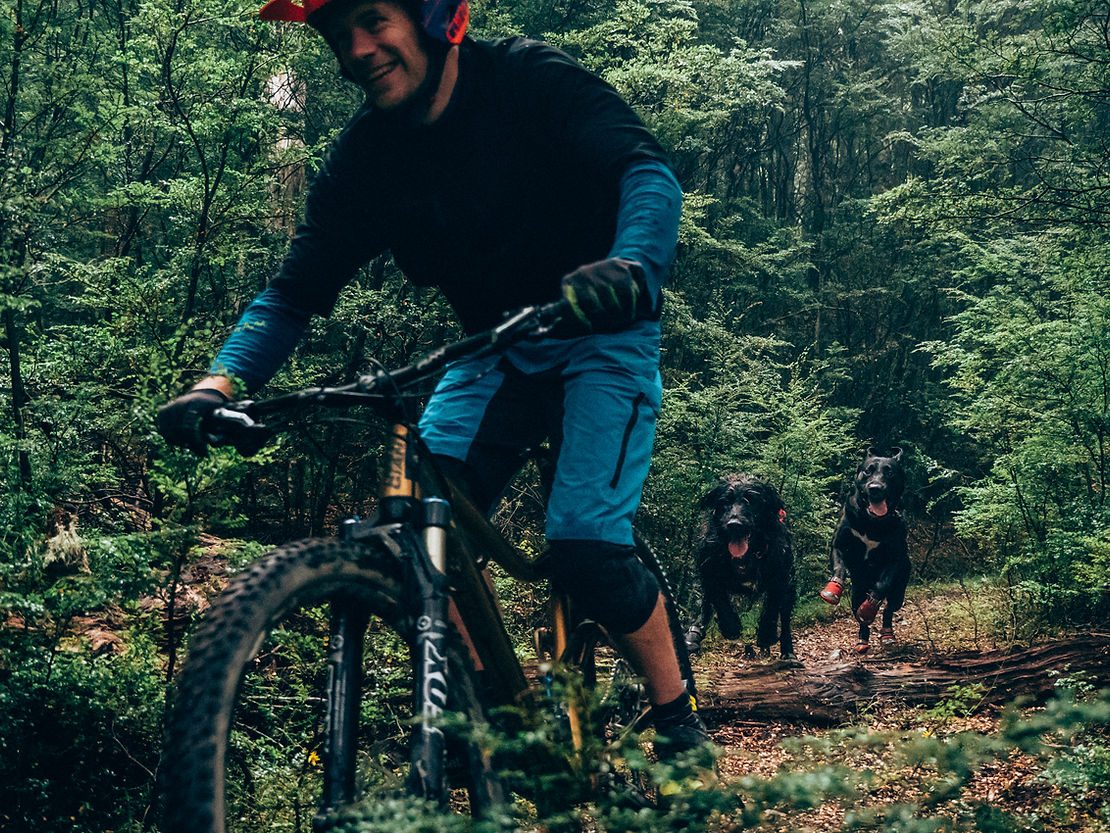
What I hadn’t taken into consideration this time was Oshy’s excitement at another trail dog and new riders. Sadly, he expressed this emotion the only way he knows how – barking. No amount of biscuits, polite requests to cease and desist or ‘time outs’ in the car seemed to have an effect. After just two runs we had to call it a day. Something I’ve come to realise with Oshy is that if it’s not working then don’t force it. Similar to those rides where you have endless mechanicals or repeated crashes, it’s best to just draw a line under it.
Through a rain covered windscreen I watched Todd and Agata set off for another lap, with Frank bounding happily – and silently – after them. I rolled my eyes and wondered why I bother. I turned to face Oshy and was greeted with a large pink tongue trying to clean my mud covered face. He then sat back with a huge grin across his chops, giving me the only reason I needed.
Words: Ian Middleton
Images: The Perfect Line

